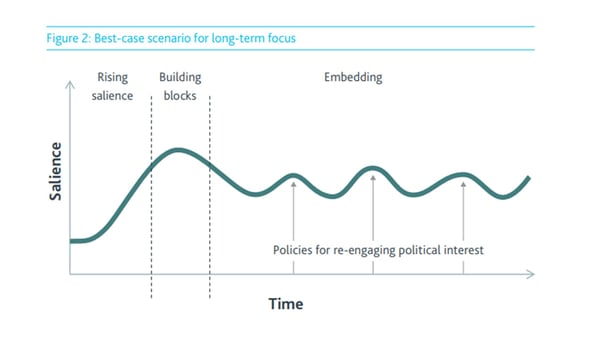The Power of Execution: Enhancing Policy Implementation in the UK
 Chloe Martin
·
5 minute read
Chloe Martin
·
5 minute read
Effective policy implementation is crucial for achieving outcomes and driving positive change.
It is all well and good to develop a coherent, relevant and knowledgeable policy, but without the consideration of policy implementation, the objectives can be lost.
But how do we avoid gaps between planned outputs and outcomes of policy?
In this post, we’ll navigate policy implementation and how the government can enhance the full potential policies across the UK.
How Does a Government Policy Work?
In the UK, government policies refer to a set of principles, guidelines and decisions adopted by the government to address specific issues or achieve certain goals.
These policies are designed to provide a framework for governing and shaping various aspects of society, from the economy to public services and education. Designing policies is all about making decisions and in-depth communication between key decision-makers and implementers of policy.
An Example of a Government Policy: Clean Air Zone (CAZ)
From the housing crisis to addressing poverty and climate change, there are many issues that need time, focus and effort. But this all starts with a policy and understanding the best way to move forward to make a change.
Clean Air Zone (CAZ) Policy
Introduced in 2020, Clear Air Zone aims to improve air quality and reduce pollution in specific areas where the air quality is poor, such as:
- Bath
- Birmingham
- Bristol
- Sheffield to name a few.
CAZ involves several elements, including:
· Vehicle restrictions: Vehicles with high emissions face restrictions like entering or operating within the CAZ.
· Public transport improvement: Encourages people to use public transport instead of a private car. This means investing in service frequency and sustainability in transport.
· Local authority engagement: From enforcing the policy to collaborating to ensure the policy is tailored to the specific needs or challenges of each area.
How to Make a Policy Successful
Policymaking is not a linear process, which means success can have different definitions depending on the aims and external barriers.
However, policymakers can enhance the chances of successfully implementing policies that effectively address challenges and goals by focusing on:
-
Having clearly defined objectives: These should provide clarity and a foundation for success
-
Thorough research and evidence: Find data and research to gather evidence to support your policy.
-
Stakeholder engagement: Do this early. Speak with experts, and affected communities and build support.
-
Political leadership: This will support your policy. High-level commitment increases the likelihood of success and the ability to overcome potential obstacles.
How Do You Implement a Policy? Key Steps to Successful Policy Implementation
Define the problem/ policy justification
The first step in successful policy implementation is to clearly define the policy. This means defining its objectives, scope, and expected outcomes. Ensuring clear objectives is key to successful policy implementation. Without clear goals, the policy may waiver during implementation due to unexpected circumstances, differing stakeholder interests other factors.
Having clear objectives and goals will help to ensure that everyone understands the policy and what is required of them. It will also help prevent confusion later on.
With that in mind, effectively communicating your policy, goals and implementation strategy is crucial.
Communication
Effective communication strategies should be at the core of policy development. From design through to implementation.
Often those invested in policy development differ from those involved in the implementation stage. Leaving a potential communication gap, allowing for unintended consequences and a confused workforce.
Without objectives being clear at the highest level, goals, objectives, and priorities can become weakened. Creating a coherent communication strategy that stretches the length of the organisation is crucial.
Communication should not only be used to communicate objectives and aims but also to share wins and communicate progress. This can act as a motivation tool to display the success of the policy and demonstrate commitment to it.
Stakeholders Engagement
Keeping stakeholders at the heart of your policy implementation and decision-making process is an important step toward success. This includes those who will be responsible, as well as those who will be affected by it. This will help achieve buy-in and cooperation and will also identify any potential issues or challenges that must be addressed.
Realism and Flexibility: Resources, Timelines and Responsibilities
Ensuring that there are adequate resources available to support the implementation of policy is essential. This includes funding, staff, time, and technology. Without these resources, implementation is likely difficult or even impossible in achieving the policy’s aims. Providing adequate resources will help ensure that the policy is implemented effectively.
With this comes the acknowledgement of factors that may not have been considered which can alter the trajectory of policies. Policy implementation often requires flexibility, whether that be in terms of timelines, budgetary restrictions, or leadership choices. Recognising this from the outset enables contingencies to be put into place during policy implementation.
Leadership
Leadership plays a crucial role in policy implementation and can provide direction and reassurance where needed in several ways:
· Setting the tone: A minister’s attitude towards a policy and its implementation can influence the attitudes of others. If ministers are committed, it provides more incentive for civil servants to stay focused on achieving the policy's ambition.
· Providing Direction: Ministers or senior civil servants can provide direction and guidance to those responsible for implementing a policy. They can clarify roles and responsibilities and ensure everyone's working towards the same goal by effectively communicating policy justification and aims.
· Motivating Staff: Effective leadership can motivate staff to work towards common goals. Recognising the importance of others’ work and providing incentives can create a sense of purpose and enthusiasm.
Leadership is particularly important during long-term policy implementation, also known as the ‘Embedding’ stage. It requires political support and interest over a period of time which is difficult to maintain when new issues arise.
View Figure Two below to see how the implementation stage needs specific timestamps to reengage political interest in the issue.
Feedback/ Evaluating the Results
Evaluating the results of policy implementation is important to see whether it has achieved its objectives and if adjustments are needed. Evaluation should be done at regular intervals throughout the implementation process.
This will help ensure that the policy is achieving its intended outcomes and that it is being implemented effectively. A crucial aspect of effectively assessing the success of a policy is welcoming and responding to feedback.
Feedback mechanisms between policymakers and other interested or involved parties are vital to monitor the success of a policy. Ensuring it is being implemented as intended, unexpected/ unforeseen consequences, enabling them to be addressed efficiently.
Regular opportunities for feedback creates a culture of open communication and a willingness for policy development to recognise where to improve.
Potential Barriers Affecting Policy Implementation
Without these considerations for policy implementation, there is substantial room for oversight and poor outputs.
Of course, there may be potential barriers to policy implementation that may not have been considered. These barriers can limit the way in which a policy is being implemented.
This is especially common with long-term policies which are historically difficult for government to drive forwards.
Barriers to Policy Implement Can Include:
External Factors
· Changes to legislation that impact policymaking and can have drastic impact on implementation, timelines and outcomes
· Influence of third parties that disrupts the intended implementation plan
· Resource prioritisation
Internal Factors
· Unexpected changes to staffing levels, due to sickness or resignation, that can shift the workload and further impact the implementation process
· Shifting political leadership or inconsistent personal leadership by ministers due to reshuffles – at both a policy leadership level and a centre-of-government level
· Lack of resources, unable to obtain the funding that had initially been planned for
· Initial targets being met but failure to set additional goals
· Technological failure or failure to adopt the correct technology to aid the implementation
Although it is difficult to predict all potential barriers, it does highlight the importance of flexibility and effectively communication throughout. Acknowledging that unexpected changes may occur limits the potential impact they can have on the implementation of your policy.
How Can We Improve Government Policy Implementation?
-
Stronger stakeholder engagement
-
Analyse previous experiences: Identify and analyse previous policy implementation experiences that were successful and unsuccessful to understand where to improve.
-
Improve flexibility and adaptability: The policy implementation stage may need adjustments similar to the policy-making stage. Be willing to make necessary changes and leave enough time to have these approved if needed.
-
Training: Continuously develop the skills and knowledge to ensure responsibilities are clear and effective.
Develop Cohesive Policy Implementation Strategies Through Training
To gain a more in-depth understanding of a successful policy implementation process, attend our Ensuring Effective Policy Implementation training.
2+ years in SEO and content marketing. Striving to help public sector professionals develop their skills and learn something new through high-quality content.


compressed.jpg?width=800&height=525&name=1%20(2)compressed.jpg)





